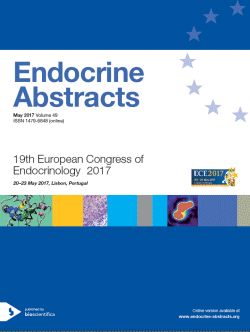
19th European Congress of Endocrinology
Lisbon,
Portugal
20 May 2017 - 23 May 2017
Eposter Presentations: Interdisciplinary Endocrinology
Nuclear receptors and Signal transduction
ea0049ep801 | Nuclear receptors and Signal transduction | ECE2017
18β-glycyrrhetinic acid reduces VLDL secretion as a modulator for HNF4α
Liu Qingli , Yang Meng , Zhang Minyi , Guan Min
ea0049ep802 | Nuclear receptors and Signal transduction | ECE2017
5α-THB as a novel anti-inflammatory drug: The roles of the glucocorticoid and mineralocorticoid receptors
Abernethie Amber , Gastaldello A , Morgan RA , Mitchell C , McInnes KJ , Beck K , Odermatt A , Houtman R , Melchars D , Meijer OC , Hadoke PWF , Livingstone DEW , Walker BR , Andrew R
ea0049ep803 | Nuclear receptors and Signal transduction | ECE2017
Development of novel human stable reporter cell line for the assessment of PPARγ transcriptional activity
Illes Peter , Grycova Aneta , Prichystalova Hana
ea0049ep804 | Nuclear receptors and Signal transduction | ECE2017
Functional characterization of inherited S127F substitution in V2 vasopressin receptor revealed a loss-of-function mutation leading to nephrogenic diabetes insipidus
Erdelyi Laszlo , Balla Andras , Hunyady Laszlo
ea0049ep805 | Nuclear receptors and Signal transduction | ECE2017
Effects of human interleukins on transcriptional activity of vitamin D receptor in transgenic gene reporter cell lines IZ-VDRE and IZ-CYP24
Bartonkova Iveta , Grycova Aneta , Dvorak Zdenek
ea0049ep806 | Nuclear receptors and Signal transduction | ECE2017
3-Iodothyronamine induces transient receptor potential melastatin 8 (TRPM8) channel activation in human corneal endothelial cells and human corneal keratocytes
Ljubojevic Nina , Khajavi Noushafarin , Lohse Katharina , Valtink Monika , Mergler Stefan
ea0049ep807 | Nuclear receptors and Signal transduction | ECE2017
Cytotoxic activity of plant extracts from Brazilian biome in prostate cancer cell lines
Cardoso Sarah , Andrade Matheus , Cunha Vinicius , Silva Cristian , Rodrigues Patricia , Leao Mayra , Fagg Christopher , Guerra Eliete , Neves Francisco , Simeoni Luiz , Silveira Damaris , Lofrano-Porto Adriana



